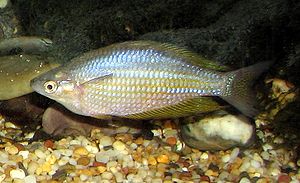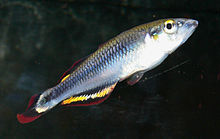Cornfish
| Cornfish | ||||||||||||
|---|---|---|---|---|---|---|---|---|---|---|---|---|

|
||||||||||||
| Systematics | ||||||||||||
|
||||||||||||
| Scientific name | ||||||||||||
| Atheriniformes | ||||||||||||
| Rosen , 1964 |
The ear fish-like (Atheriniformes) are an order of mostly small bony fish (Osteichthyes). Most of the species are silvery, only the males of the rainbow fish (Melanotaeniidae) are often very colorful.
distribution
Cornfish are common worldwide, but in very widely isolated areas. Most species live in the tropics and subtropics . 210 species live mainly in fresh water , but there are also numerous species that occur in brackish water . 58 species live on the coasts of North America , further species in Central America and Cuba , on Madagascar , in parts of Southeast Asia , in the Philippines , in New Guinea and in the rivers of North and East Australia .
Only two species live in the North Sea : from the Old World earfish family, the common earfish ( Atherina presbyter ) and the small earfish ( Atherina boyeri ), which occurs only on some sections of the Dutch and British coasts. In the Mediterranean there are two other species, Atherina hepsetus and Atherinomorus lacunosus , which only recently migrated through the Suez Canal ( Lesseps migration ).
features
Spearfish are usually rather small, mostly silvery fish with an elongated, laterally flattened body. Exceptions are especially the often strikingly brightly colored male rainbow fish, which in many cases can become relatively high backed with increasing age. The largest species of the earfish , Odontesthes bonariensis , grows to half a meter.
Spike fish usually have two dorsal fins, the first is supported by flexible fin spines, the second by a flexible spine and subsequent soft rays. It is probably homologous to the only dorsal fin of the closely related dentist (Cyprinodontiformes). The anal fin usually has a spine followed by soft rays. The pectoral fins sit high on the body. In most cases, the pelvic fins are on the abdomen, less often on the chest or throat. A sideline is only poorly developed and reduced to a few pits or channels in the middle of the body or is completely absent. The nostrils are paired. The number of Branchiostegal rays is 4 to 7. The parietal bone is missing in some families, in others it is present. The body of the earfish, including its head, is covered with round scales. They have gullet teeth and are physocists , i. H. The swim bladder and bowel are not connected to one another.
A distinctive feature of the earfish larvae is a single row of melanophores on the dorsal midline, while the larvae of most other atherinomorphae have two or more rows of melanophores. The preanal length (length in front of the anus) of the larvae is less than 40% of the body length. In most of the other Eurypterygii it is longer.
External system
The earfish-like species, together with the garfish-like (Beloniformes) and the toothfish (Cyprinodontiformes), form the superordinate order of the earfish relatives (Atherinomorpha (e)), which is differentiated from the perch relatives (Percomorpha) in older classifications, but also in Nelson (2006) . However, recent studies see the earfish relatives within the Percomorpha (ceae).
Internal system
The earfish-like include 48 genera and over 310 species . There are currently different views on the number of families .
The system used by Joseph S. Nelson in Fishes of the World (2006) assumes six families. The closely related groups of the Malagasy ear fish, the blue-eyed fish, the sunbeam fish and the rainbow fish in the narrower sense were combined as subfamilies within the family of Melanotaeniidae. In 2004 these geographically distant groups were established as separate families because of their differences. To indicate their monophyly, the four new families were put together in the new suborder rainbow fish relatives (Melanotaenioidei). However, this subordination is not generally recognized because it is in contradiction to other groupings within the higher systematics of the earfish-like. However, it is also the most sensible order for practitioners.
A 2012 study using comparative genetic analysis came to the conclusion that the families Atherinopsidae, Notocheiridae and Atherinidae are not monophyletic . According to this, Notocheirus hubbsi is part of the New World earfish (Atherinopsidae), while the genus Iso is the sister taxon to a clade from all other Old World earfish families.
System according to Joseph S. Nelson with addition by John S. Sparks and W. Leo Smith:
- Order atheriniformes
-
Newworldly earfish (Atherinopsidae)
- Subfamily Atherinopsinae
- Subfamily Menidiinae
- Isonidae
- Notocheiridae
- Dentatherinidae
- Throat phallus fish (Phallostethidae)
-
Old world earfish (Atherinidae)
- Subfamily Atherinomorinae
- Subfamily Atherininae
- Subfamily Bleheratherininae
- Subfamily Craterocephalinae
- Subordination rainbow fish relatives (Melanotaenioidei)
- Rainbow fish (Melanotaeniidae)
- Malagasy earfish (Bedotiidae)
- Blue eyes (Pseudomugilidae)
- Sun ray fish (Telmatherinidae)
-
Newworldly earfish (Atherinopsidae)
According to the latest and most comprehensive system (as of 2015), the earfish-like are classified as follows:
- Order Atheriniformes Rosen 1966
- Subordination atherinopsoidei
- Family Atherinopsidae Fitzinger 1873
- Subfamily Atherinopsinae Fitzinger 1873
-
Tribus Atherinopsini Fitzinger 1873
- Genus Atherinops Steindachner 1876
- Genus Atherinopsis Girard 1854
- Genus Colpichthys Hubbs 1918
- Genus Leuresthes Jordan & Gilbert 1880
- Tribus Sorgentinini Pianta de Risso & Risso 1953
- Genus Basilichthys Girard 1855
- Genus Odontesthes Evermann & Kendall 1906
-
Tribus Atherinopsini Fitzinger 1873
- Subfamily Menidiinae Schultz 1948 (therein incertae sedis : Xenomelaniris brasiliensis , Atherinella venezuelae , Atherinella robbersi )
- Tribus Menidiini Schultz 1948
- Genus Labidesthes Cope 1870
- Genus Melanorhinus Metzelaar 1919
- Genus Menidia Bonaparte 1836 (including Chirostoma and Poblana )
- Tribus Membradini Chernoff 1986
- Genus Membras Bonaparte 1836 (including Atherinella )
- Tribus Menidiini Schultz 1948
- Subfamily Notocheirinae Schultz 1950
- Genus Notocheirus Clark 1937
- Subfamily Atherinopsinae Fitzinger 1873
- Family Atherinopsidae Fitzinger 1873
- Subordination Atherinoidei (therein incertae sedis: Cairnsichthys )
- Family Atherinidae Risso 1827
- Family Atherionidae Schultz 1948
- Family Bedotiidae Jordan & Hubbs 1919
- Family Isonidae roses 1964
- Family Melanotaeniidae Gill 1894
- Family Phallostethidae Regan 1916
- Family Pseudomugilidae Kner 1867
- Family Telmatherinidae Munro 1958
- Subordination atherinopsoidei
swell
literature
- D. Campanella, LC Hughes, PJ Unmack, DD Bloom, KR Piller, G. Ortí: Multi-locus fossil-calibrated phylogeny of Atheriniformes (Teleostei, Ovalentaria) . In: Molecular Phylogenetics and Evolution . tape 86 , 2015, p. 8–23 , doi : 10.1016 / j.ympev.2015.03.001 . ; (pdf)
- Joseph S. Nelson : Fishes of the World . John Wiley & Sons, 2006, ISBN 0-471-25031-7 .
Individual evidence
- ↑ Odontesthes bonariensis on Fishbase.org (English)
- ^ Nelson (2006), p. 266.
- ↑ Kurt Fiedler: Textbook of Special Zoology, Volume II, Part 2: Fish . Page 317, Gustav Fischer Verlag Jena, 1991, ISBN 3-334-00339-6
- ^ EO Wiley & G. David Johnson: A teleost classification based on monophyletic groups. in Joseph S. Nelson, Hans-Peter Schultze & Mark VH Wilson: Origin and Phylogenetic Interrelationships of Teleosts. 2010, Verlag Dr. Friedrich Pfeil, Munich, ISBN 978-3-89937-107-9
- ^ A b John S. Sparks and W. Leo Smith: Phylogeny and biogeography of the Malagasy and Australasian rainbowfishes (Teleostei: Melanotaenioidei): Gondwanan vicariance and evolution in freshwater. Molecular Phylogenetics and Evolution, 33, 3, pp. 719-734, 2004
- ↑ D. Bloom, P. Unmack, A. Gosztonyi, K. Piller, N. Lovejoy: It's a family matter: Molecular phylogenetics of Atheriniformes and the polyphyly of the surf silversides (Family: Notocheiridae). Molecular Phylogenetics and Evolution. 62, No. 3, 2012. pp. 1025-1030
- ↑ Nelson (2006), pp. 267-275.
- ↑ Daniela Campanella, Lily C. Hughes, Peter J. Unmack, Devin D. Bloom, Kyle R. Piller, Guillermo Ortí: Multi-locus fossil-calibrated phylogeny of Atheriniformes (Teleostei, Ovalentaria). Molecular Phylogenetics and Evolution, March 2015, DOI: 10.1016 / j.ympev.2015.03.001 .
Web links
- Cornfish on Fishbase.org (English)

